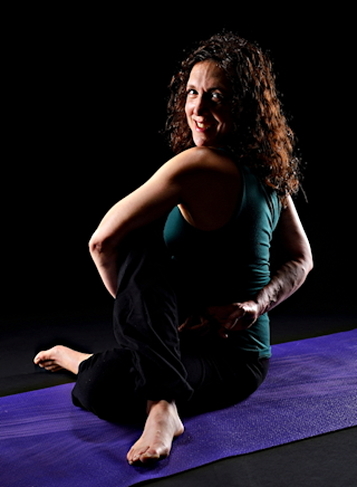Yoga.

Yoga Classes
I offer group classes and individual instruction in Vinyassa and Power Yoga.
The Vinyassa format is made up of flow sequences that focus as much on the pose itself (such as Triangle, Half Moon, and Warrior poses) as the transitions between poses to create a continuous movement from one position to the next. There is usually an aerobic element in Vinyassa because of the continuous movement. In Power style, there are also flow sequences that include a special focus on the core (the area from the chest to the upper thighs). Power Yoga typically involves many repetitions of various muscle groups to strengthen those areas and build stamina and flexibility.
Both types of classes involve an arc of activity starting with a very thorough stretching sequence that both feels good and prevents injury. Activity increases gradually, and our heart rate goes up; by midway into class, we crescendo with a few challenging poses, and then work our way back to a resting/stretching sequence towards the end of class that leaves us feeling calm and centered.
To find out about classes and sign up, contact me here.
Yoga Philosophy on the Mat
Yoga classes inspire when they both are enjoyable (making us want to come back from more) and help us work productively with states of mild discomfort. Why is this important to do? By increasing our capacity to tolerate mild to moderate levels of discomfort, we become stronger, more internally and externally flexible, and calmer in facing the challenges we encounter in daily life off the mat. Yoga is an excellent practice to lower anxiety, increase our ability to respond well, and reduce the compulsion to thoughtlessly react. In short, yoga makes us more resilient.
Yoga Philosophy in the Consulting Room
The practice of yoga can help us become a better version of ourselves — increasing our ability to focus attention, calm the mind, and reduce agitation and reactivity to stressors. Learning a few basic breathing techniques combined with gentle movement will help you work more productively and efficiently in therapy.
Why is this? With your anxiety at a manageable level, you will be able to get to the heart of whatever difficulties you came in with, identify and experience your feelings, clarify what is important to you, and think clearly so you can more readily solve problems in the real world.
Yoga and Psychotherapy
How can methods of yoga move a psychotherapy meeting forward? Many clients experience spikes in anxiety when discussing topics that are emotionally charged. When anxiety gets too high, it interferes with thinking clearly and processing complex feelings.
Here’s where yoga can be quite helpful. Integrating breath-awareness practices during therapy, sometimes combined with gentle movement, can help anxiety levels begin to drop and work in therapy become more productive.
Consider these examples.
- A young male client who had been terminated from a job unexpectedly became paralyzed by anxiety whenever he started looking for new work. He described being prone to panic attacks, and had trouble thinking clearly when he practiced mock interviews. By using a simple method of three full cycles of a three-count inhalation and a five-count exhalation, the client was able to lower his anxiety in under 30 seconds and resume his train of thought in mock interviews. Being able to self-manage his anxiety also helped him increase his confidence and take more risks by checking out new positions he had not considered before.
- A husband and wife who want to be more emotionally intimate with each other arrive for couples counseling. The woman gets very anxious and starts to tear up whenever she tells her husband something that makes her angry with him. By crying rather than expressing her anger, she inadvertently sends him mixed signals, and he concludes that what is bothering her is no big deal. A simple technique of having the wife observe her anxiety in her body, from head to toe, could lower her anxiety, interrupt the automatic weepy tears, and enable her to assert herself effectively with her husband, helping him understand what’s bothering her, and that she’s angry about it.
- Yoga-Informed Psychotherapy
- Yoga Psychotherapy to Treat Trauma
Background and Training
I received certification as a yoga teacher in spring of 2008 through the Avalon Art and Yoga Center teacher training program in Palo Alto, CA. Following graduation from Avalon, I began teaching Vinyassa-style yoga at several yoga studios on the Peninsula and through the Mind/Body Medicine program at Kaiser Permanente. I have also taught Power Yoga classes. I have designed and taught yoga classes focused on themes of prayer and rest, called “Yoga for Connecting Heaven and Earth,” presented at the Kallah and Limud conferences, and have taught the yoga portion of several Yoga/Kirtan events held at the Chochmat Halev spiritual community center. I taught yoga for a week-long psychotherapy conference. I am passionate about yoga, and practice daily.
|
|
| “ |
I have known Diane Byster for 12 years, and it has been a true pleasure. I met Diane in one of my Power Yoga classes I taught at Yoga Source, a studio in Palo Alto. I remember feeling a warm and inviting energy every time she took the class, and I found myself feeding off of her energy — so much so that when she didn’t make it to class, I sincerely felt her absence, knowing the special vibe she exudes was missing, making me wish she would be back ASAP! — Tracy Gulbransen, RYT |
” |